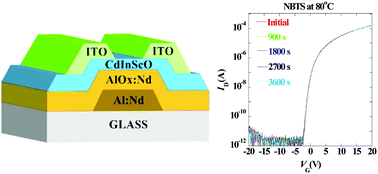High-performance CdScInO thin-film transistors and their stability improvement under negative bias (illumination) temperature stress†
Abstract
Recently, the performance of thin-film transistors (TFTs) with amorphous oxide semiconductors (AOSs) has been substantially improved. However, the device reliability under negative bias illumination/temperature stress (NBI/TS) remains a critical issue. Herein, a Cd and Sc co-doped In2O3 semiconductor (CdScInO) is developed for improving the NBI/TS stability of TFTs. The mobility, subthreshold swing, and on/off ratio of the CdScInO TFT are 15.9 cm2 V−1 s−1, 89 mV dec−1 and ∼107, respectively. More interestingly, the CdScInO TFTs exhibit excellent stability under NBTS at 80 °C or under NBIS with red light or green light illumination, while a threshold voltage shift of only −0.91 V is observed under NBIS with blue light illumination for 3600 s. First-principles calculations show that the Cd dopants cause the formation of holes, which can be bound with oxygen vacancies (VOs) to form Cd–VO pairs. Furthermore, the density of states near the valence band maximum decreases due to the upward repulsion between the O p states and the Cd d states. Thus, the activation of VO or electron donor defects is suppressed, which explains the NBI/TS stability improvement for CdScInO TFTs.

- This article is part of the themed collection: 2019 Journal of Materials Chemistry C HOT Papers


 Please wait while we load your content...
Please wait while we load your content...